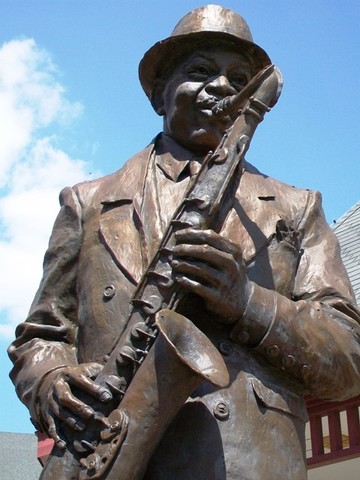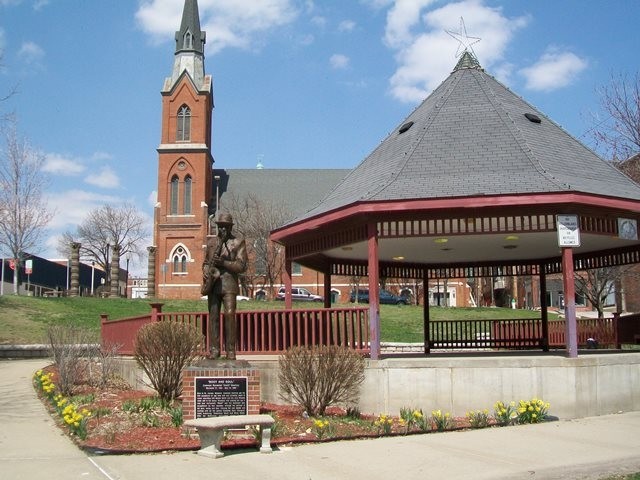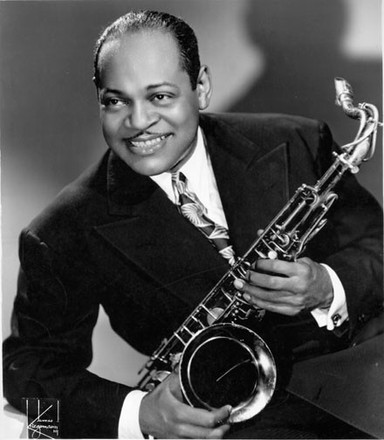Coleman Hawkins Statue
Introduction
Text-to-speech Audio
This bronze statue commemorates one of the greatest jazz saxophonists of all time, Coleman Hawkins, who was born in St. Joseph in 1904. Created by artist Herb Mignery, it was unveiled in 2008, which was the tenth anniversary of the Coleman Hawkins Jazz Festival. Hawkins is known as the "father of the tenor saxophone" and performed with other great jazz musicians including Louis Armstrong, Miles Davis, and Duke Ellington in a career that spanned four decades. The statue depicts Hawkins playing his saxophone and is located in a park named after him.
Images
The Coleman Hawkins statue is located in the park named after Hawkins, who was born in St. Joseph in 1904.


Hawkins in 1945.

Backstory and Context
Text-to-speech Audio
Hawkins was born on November 21, 1904. He started taking piano lessons when he was five then switched to cello when he was seven. He permanently switched to the tenor sax when he was eleven. Interestingly, the tenor sax was not well regarded at the time and only played in vaudeville shows or as a substitute for the trombone in marching bands. Within a year, Hawkins was already playing professionally. In 1921, popular vaudeville blues singer Mamie Smith hired him to play in her band called the Jazz Hounds. He toured with Smith for about two years then freelanced for a while before joining an orchestra led by Fletcher Henderson. Louis Armstrong joined the orchestra in 1924 and he influenced Hawkins' playing style significantly. Hawkins became a top soloist by 1925 and he also played the clarinet and bass saxophone in the orchestra.
Hawkins left the orchestra in 1934 and toured Europe for five years. During that time he performed with the Jack Hylton Orchestra in England and freelanced around the rest of Europe. He came back to America in 1939 with World War II looming and, despite being gone for five years, soon reestablished himself as one of the country's best saxophonists. That year he recorded his first famous song "Body and Soul." He recorded some of his best songs in the early 1940s and performed with a number of up and coming artists including Miles Davis and Dizzie Gillespie. From 1946 to 1950 he toured with the Jazz at the Philharmonic in Europe a few times.
Other tenor saxophonists, such as Lester Young, had emerged in the 1940s and developed a newer style and as a result, some considered Hawkins's style outdated. Hawkins continued to perform and record, however, and grew in popularity once more in the mid-1950s as he took an interest in newer styles. A notable performance in this period was in 1957 when he played with trumpetist Roy Eldridge at the Newport Jazz Festival.
In the early 1960s, Hawkins performed at the Village Vanguard jazz club in New York City and recorded with Duke Ellington and tenor sax player Sonny Rollins. Unfortunately, Hawkins succumbed to depression and heavy drinking by 1965. His work output diminished greatly and his last recording was in 1967. Two years later on May 19, he died of liver disease, leaving a wife, son, and two daughters.
Sources
"Coleman Randolph "Hawk" Hawkins November 21, 1904 - May 19, 1969." The Historical Marker Database. Accessed October 6, 2022. https://www.hmdb.org/m.asp?m=66410.
Yanow, Scott. "Coleman Hawkins Biography." All Music. Accessed October 6, 2022. https://www.allmusic.com/artist/coleman-hawkins-mn0000776363/biography?1664988039465.
The Historical Marker Database
Wikimedia Commons
